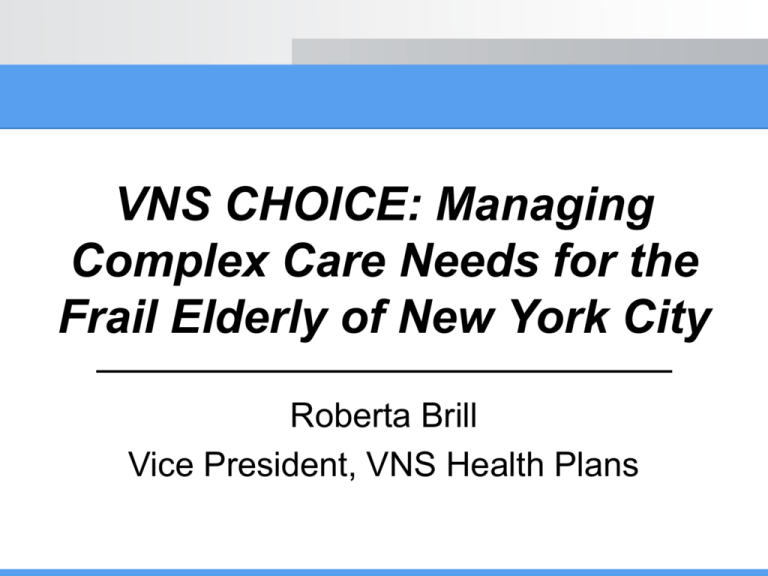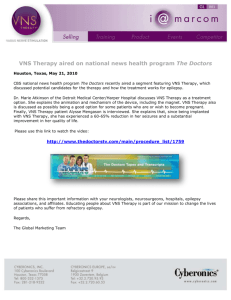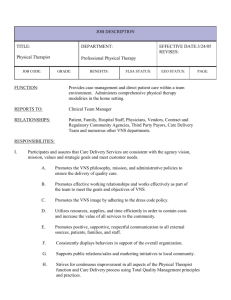Powerpoint
advertisement

VNS CHOICE: Managing Complex Care Needs for the Frail Elderly of New York City Roberta Brill Vice President, VNS Health Plans VNS CHOICE Organization • Subsidiary of the Visiting Nurse Service of New York • Licensed by New York State Department of Health as a Managed Care Organization • Product Lines: • VNS CHOICE MLTC (Medicaid Managed Long Term Care) - Initiated operations January 1998 - 6,100 members (April 2008) • VNS CHOICE Medicare - Initiated operations January 2007 - Two Dual Eligible Special Needs Plans - 1,400 members (April 2008) • VNS CHOICE MLTC PLUS - Initiated operations May 2008 - Integrated MA and MLTC benefit for dual eligible & nursing home eligible VNS CHOICE OVERVIEW OF MANAGED LONG TERM CARE VNS CHOICE MLTC Membership • Basic Criteria – – – – Age 65 or older Resident of the service area (5 boroughs of NYC) Medicaid eligible Community physician must agree to work with VNS CHOICE • Clinical Requirements – Nursing home eligible as determined by a standard New York State assessment tool – Long term care needs anticipated to continue for at least 120 days – Must satisfy New York home care health and safety standards at the time of enrollment • Cannot be disenrolled if needs change MLTC Covered Services • Care management • Skilled home health care – Nursing – Rehabilitation therapies – Social Work – Nutrition • HHA and PCW • Outpatient rehab therapies • Substitutes for home care services – Adult day services (social and medical models) – Home-delivered meals – Chore services – PERS • Ambulatory health services – Dental – Optometry/eyeglasses – Audiology/hearing aids – Podiatry • Scheduled transportation to health related appointments • Respiratory therapy • DME and supplies • Environmental modifications • Nursing home care • Note: Physician and hospital services excluded from capitation; however, MLTC plan is responsible for care management of these services MLTC Program Financing • Capitated reimbursement – Medicaid capitation for long term care services and care coordination – Fixed per member per month premium • Program is at full financial risk for all covered services • Financing requires efficient utilization of resources – Focus on providing quality care and using resources effectively and efficiently – Use of substitute services where appropriate (adult day centers and meals on wheels services) – Emphasis on prevention, management of chronic illness and fostering independence MLTC Interdisciplinary Team Model • Regionally based care management teams including – Nurse Consultant – Social Worker – Nurse Practitioner – Rehabilitation Consultant – Nutritionist • Care management across all settings – Community, hospital and nursing home • Member-focused care planning – Member choice regarding services and scheduling – Family/caregiver involvement encouraged • Communication and coordination with member, family, community providers, physicians and care team – Scheduled team meetings and informal discussions with care team members Care Team Interventions • Preventive screening initiatives for all members – Examples include: Influenza, Pneumococcal, diabetes, osteoporosis, and cancer • Comprehensive falls prevention program – Proactive screening tool and team interventions • Management of key chronic illnesses – For members with diabetes: HbA1c and ongoing blood glucose monitoring and education; focus on podiatry and vision care – For members with CHF: Consistent weight monitoring and education • Drug utilization review for new medications – Interventions by Pharmacist Consultant regarding medications considered unsafe for the elderly • Home safety modifications – Grab bars, wheelchair ramps, PERS VNS CHOICE VNS CHOICE MEDICARE Medicare Advantage Special Needs Plan What is a Special Needs Plan • Special Needs Plans (SNPs) are Medicare Advantage plans that serve Medicare beneficiaries based on specific criteria: – Institutionalized in a Skilled Nursing Facility – Chronic condition(s) – Dually eligible (Medicare and Medicaid) • VNS CHOICE Medicare is a SNP for dually eligibles • SNPs cover all Medicare services – Part A (Hospital and other inpatient services) – Part B (Physicians and other outpatient services) – Part D (Prescription drug coverage) • Care management is a critical component – Health assessments provided for all new enrollees – Care management programs for people identified with high needs – Care coordination for all when inpatient services are needed • Value added services improve access – Preventive benefits, annual physical, 24-hour nurse-on-call The Value of a SNP to VNSNY • Retain Medicare patients • Build new customer base • Leverage and build upon relationships with providers • Build upon VNSNY’s care/medical management competency • Provides a more integrated care option for a nursing home eligible individual who lives at home • Creates a referral channel for VNSNY Home Care and VNS CHOICE MLTC VNSNY is Positioned to Offer SNP • Medicare Advantage SNP fits conceptually with current VNSNY customer base • Nursing resources – Increase value of assessment information – Provide office and field based care coordination • Multicultural expertise – Valuable in a city like New York • VNS CHOICE has been successful since 1998 in managing a risk product – Core managed care competencies in managing enrollment, capitated financing, claims payment, quality management, grievance and appeal, regulatory compliance VNS CHOICE Offers Value for Enrolled Members • Assistance in navigating complex health care system – Advocate for entitlements and benefits – Coordination with long term care services and programs • Comprehensive disease/care management provided by nurses – Assessment of health status and needs upon enrollment – Outreach to ensure members know how to use a Medicare Advantage plan – Plan for improving self care management and medical management – Health education – Goal is to maintain/improve management of chronic diseases Benefits Focus on Access to Care • Plan features designed to improve access to care – Prescription drug coverage with extensive formulary and few requirements for prior authorizations – $0 Premiums and co-payments for most services – No referrals required to see specialists • VNS CHOICE supplemental benefits include: – Transportation to medical appointments – Nurse Ambassador – In-home assessment and consultation, at the member’s request – Enhanced Vision Benefit – Zero dollar co-pay option for generic prescription drugs – International coverage for many services 2008 VNS CHOICE Medicare Products • VNS CHOICE Medicare - Option 1 – – – – MA-PD, Dual Eligible SNP $0 Co-payments for Generic prescription drugs International coverage Vision, Hearing, Transportation and other supplemental benefits • VNS CHOICE Medicare - Option 2 – MA-PD, Dual Eligible SNP – Wellness benefit that includes fitness club, acupuncture, massage therapy – International coverage – Dental care – services not covered by Medicaid in New York State – Vision, Hearing, Transportation and other supplemental benefits VNS CHOICE Medicare Service Model • High touch – Minimum of 5 member contacts in first 3 months • Low staffing ratios – Personalized service – Consider members full care needs • Simple for members – No confusing phone trees for members – Multi-cultural capabilities – Customized communications • Proactive outreach to providers • Limited reliance on traditional Utilization Management methods • Close collaboration with VNS CHOICE MLTC for dually enrolled members VNS CHOICE Care Management Strategies • Stratify members – Appropriate levels of care and intervention at the right time • Involve members and their families – Individualized care plans based on need and preference – Structured assessments • Collaborate with community physicians – Physician participation in care planning process – Goal: A common and shared understanding of a member’s medical needs • Coordinate with community providers – Assess provider’s ability to satisfy member needs – Appointments and transportation to community providers may be arranged by the program VNS CHOICE VNS CHOICE MLTC PLUS An integrated plan combining a Medicare Advantage Special Needs Plan with Managed Long Term Care VNS CHOICE 2008 • MLTC PLUS: an integrated plan that covers both Medicare and Medicaid services for a nursing home eligible population – An important policy goal of state and federal governments is to find more efficient ways to deliver care to dual eligibles • Reduce expenses for one of the most expensive subgroups of Medicare recipients • Reduce regulatory confusion and disconnects – New York State an early adopter of integrated model of health plan that combines Medicare Advantage plan with Medicaid managed long term care – CMS has permitted plans with state contracts to market to a segment of the dual eligible population • Enrollment beginning May 2008 – A pilot project: start small and build for the future – Work with CMS and DOH to refine regulatory requirements, which can be inconsistent VNS CHOICE MLTC Plus • Covered services – All Medicare services (Part A, Part B, and prescription drug coverage) – All MLTC services – State defined Medicaid benefit, which then drives Medicare services • Two contracts (CMS and State DOH) – Two capitation payments • Builds on care management strengths of MLTC and medical management of Medicare Advantage • Uses provider network developed for MLTC and Medicare Advantage MLTC and Medicare Networks MLTC MA-SNP Audiology Gastroenterology Ophthalmology General Practice Oral Surgery Acute Care General Surgery Orthopedics Dental Cardiology Geriatrics Podiatry DME Chiropractic Internal Medicine Pharmacy CORF facilities Lab Psychiatry Home Health Care Dermatology Mammography Pulmonology Endocrinology Mid-Level Pract Radiology ENT Nephrology Radiology Family Practice Neurology Rheumatology OB/GYN Transplant Access Nursing Home Oncology Urology Vision Outpatient Rehab. Adult day health care Home-delivered meals Medical Social Services Non-emergency transportation Personal emergency response system Private Duty Nursing Prosthetics and orthotics Respiratory therapy Social day care Social Supports and modifications Speech Therapy Lessons Learned • Commercial authorization rules do not fit – Plan experience is a better guide – Access to needed services is critical – Gatekeeper approach hinders collaboration and reduces efficiency of staff • Network matters – Members will not change providers, especially during a course of treatment • High touch, proactive and responsive service is critical • Staff education is key – Care management of long term care and medical management of acute and medical care are different skill sets VNS CHOICE Questions?







